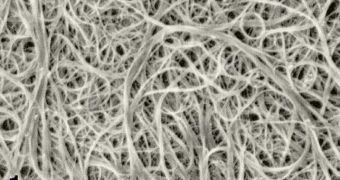A group of investigators from the United States announces the development of a new method for boosting the near-infrared fluorescence level of single-walled carbon nanotube, that only involves adding a little bit of ozone to the mix.
Just tiny batches of the compound allow for entire groups of carbon nanotubes to be “decorated” with oxygen atoms, once they are exposed to light. This allows the group to obtain systematic changing in the type of near-IR fluorescence the tubes exhibited.
Generally, CNT have their own natural luminescence in the IR portion of the electromagnetic spectrum, but the various chemical reactions that develop on the surface where the tubes are grown tend to interfere with that ability, reducing it by a considerable margin.
Nanotube spectroscopy pioneer and physical chemist Bruce Weisman, a professor at the Rice University, says that the new method developed by his team is capable of enhancing the intensity of the CNT natural glow, while shifting their characteristic wavelength at the same time.
The investigator believes that the new finding may bring on new biological and material applications for nanotubes, given that their exact location within biological and artificial systems can be tracked using precision lasers.
Weisman and graduate student Saunab Ghosh says that the chemical reactions the new method implies are fairly straightforward, saying that professional chemists should have no problem triggering it.
"We're not the first people to study the effects of ozone reacting with nanotubes. That's been done for a number of years. But all the prior researchers used a heavy hand, with a lot of ozone exposure,” the Rice team leader says.
“When you do that, you destroy the favorable optical characteristics of the nanotube. It basically turns off the fluorescence. In our work we only add about one oxygen atom for 2,000-3,000 carbon atoms, a very tiny fraction,” he adds.
An added benefit of using the reaction, the team says, is that you get nanotubes that can remain stable for up to several months. The CNT cannot be detected in visible wavelengths, which is not at all a drawback, as you might be tempted to think.
“Why does that matter? In biological detection, any time you excite at visible wavelengths, there's a little bit of background emission from the cells and from the tissues,” Weisman explains.
“By exciting instead in the infrared, we get rid of that problem. There are many interesting scientific avenues to pursue,” he goes on to say.
“And if you want to see a single tube inside a cell, this is the best way to do it. The doped tubes can also be used for biodistribution studies,” the expert concludes.

 14 DAY TRIAL //
14 DAY TRIAL //